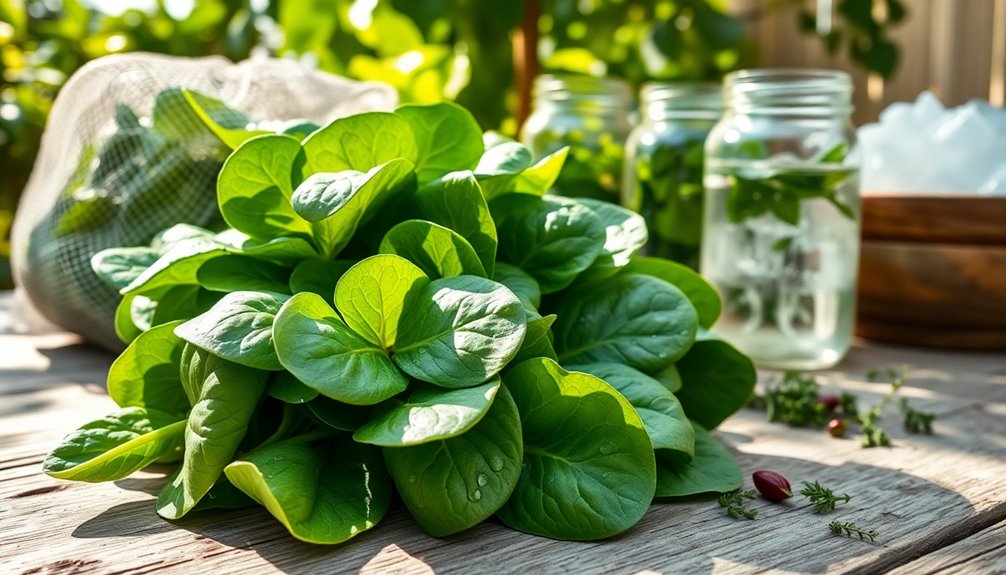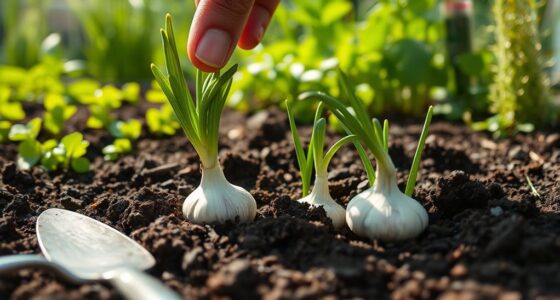You can make your own fertilizer at home using simple kitchen scraps like coffee grounds, eggshells, and banana peels. Start by drying and grinding these scraps into a powder. Mix equal parts of the dried ingredients and sprinkle them into your garden soil. This homemade mix enriches your plants with essential nutrients, promoting healthy growth. Plus, it's a sustainable way to minimize waste. Want to explore more tips and recipes for homemade fertilizers?
Key Takeaways
- Collect kitchen scraps like coffee grounds, eggshells, and banana peels to create nutrient-rich fertilizer.
- Dry food scraps in sunlight for 1-3 days until brittle before grinding them into a fine powder.
- Mix equal parts of ground coffee, eggshells, and banana peels for a balanced homemade fertilizer.
- Use compost made from kitchen scraps to enrich soil and support plant health over time.
- Store any unused fertilizer in a sealed container in a cool, dry place to preserve its effectiveness.
Benefits of Homemade Fertilizers

Homemade fertilizers offer a sustainable way to nourish your plants while minimizing waste. By recycling kitchen waste, you're not just providing cost-effective alternatives to store-bought fertilizers; you're also reducing landfill contributions.
These homemade fertilizers promote plant nourishment through a gradual nutrient release, which helps maintain healthier growth and lowers the risk of over-fertilization. Unlike synthetic options that can contaminate groundwater, your DIY fertilizers improve soil health and structure, creating a balanced ecosystem for beneficial microorganisms.
This approach not only supports robust plant growth but also contributes to a healthier environment. So, why not embrace homemade fertilizers and enjoy the advantages they bring to both your garden and the planet?
Key Ingredients for Your Fertilizer
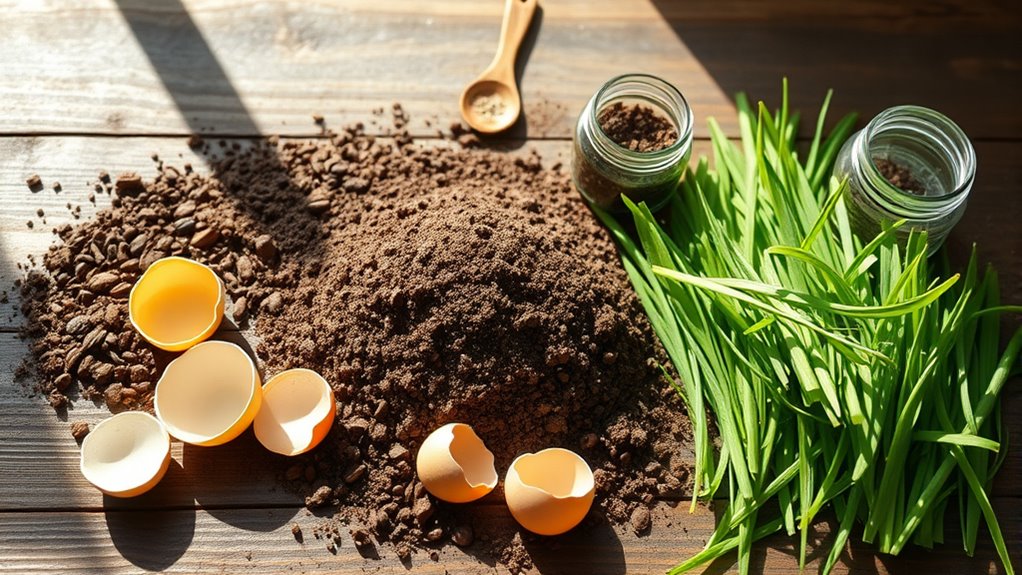
When you're making your own fertilizer, knowing the key ingredients is vital.
You can utilize kitchen scraps like coffee grounds and eggshells to boost nutrient levels, while also exploring homemade recipes that incorporate these elements.
Essential Nutrient Sources
Creating your own fertilizer starts with understanding essential nutrient sources that can boost your plants' health.
Coffee grounds are rich in nitrogen, perfect for enhancing leaf growth, and can be directly used after drying and grinding.
Eggshells provide calcium and phosphorus, strengthening cell walls and promoting root development when finely powdered.
Banana peels are high in potassium, essential for flowering and fruiting, and can be added to soil or made into a nutrient-rich tea.
Fresh grass clippings offer nitrogen and act as a natural mulch, retaining moisture and suppressing weeds.
Finally, fish waste is an excellent source of nitrogen and phosphorus, ideal for heavy-feeding plants like tomatoes and peppers.
Combine these ingredients for a powerful homemade fertilizer!
Kitchen Scraps Utilization
Utilizing kitchen scraps not only enriches your garden but also helps reduce waste. You can easily turn common items like coffee grounds, egg shells, and banana peels into an effective natural fertilizer. Here's how they contribute to your organic matter:
| Kitchen Scrap | Nutrients Provided | Preparation Method |
|---|---|---|
| Coffee Grounds | Nitrogen | Dry in sunlight, grind |
| Egg Shells | Phosphorus, Calcium | Dry, crush into powder |
| Banana Peels | Potassium | Dry until brittle, grind |
Mix equal parts of ground coffee, crushed egg shells, and dried banana peels for a balanced, slow-release fertilizer. By using these kitchen scraps, you're not just improving your soil; you're also being eco-friendly!
Homemade Fertilizer Recipes
Crafting your own homemade fertilizer is a rewarding way to nourish your garden naturally. You can make homemade fertilizer using common kitchen scraps.
Start with used coffee grounds, which enrich soil with nitrogen, perfect for acid-loving plants. Eggshells provide calcium; simply dry and grind them to prevent blossom end rot in tomatoes.
Banana peels are high in potassium and phosphorus—sun-dry, crush, or steep them for a nutrient-rich liquid fertilizer. Don't forget grass clippings, which add nitrogen and help retain moisture while suppressing weeds.
Finally, create compost by mixing kitchen scraps like fruit peels and yard waste; turn it regularly for rich, fertile soil. These ingredients will enhance your garden's health and productivity!
Step-by-Step Guide to Making Fertilizer
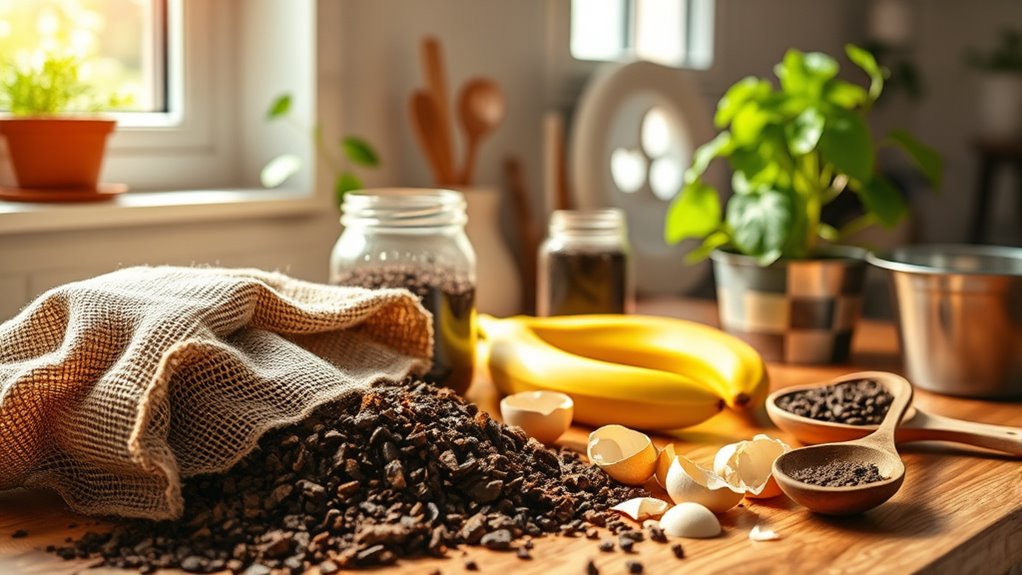
If you're looking to nourish your plants naturally and sustainably, making your own fertilizer is a simple and rewarding process.
Start by collecting common food scraps, like ground coffee, eggshells, and banana peels, which contain essential nutrients. Dry these scraps in sunlight for 1-3 days until they're brittle, then grind them into a fine powder.
Collect food scraps like coffee grounds, eggshells, and banana peels, dry them, and grind into a nutrient-rich powder for your plants.
Mix equal parts of the ground coffee, eggshells, and banana peels to create a balanced homemade plant fertilizer. To enhance nutrient quality, sprinkle this mixture on the soil every 2-4 weeks.
Any unused fertilizer can be stored in a sealed container in a cool, dry place. With this method, you can effectively make your own organic solution for thriving plants!
Different Types of Organic Fertilizers
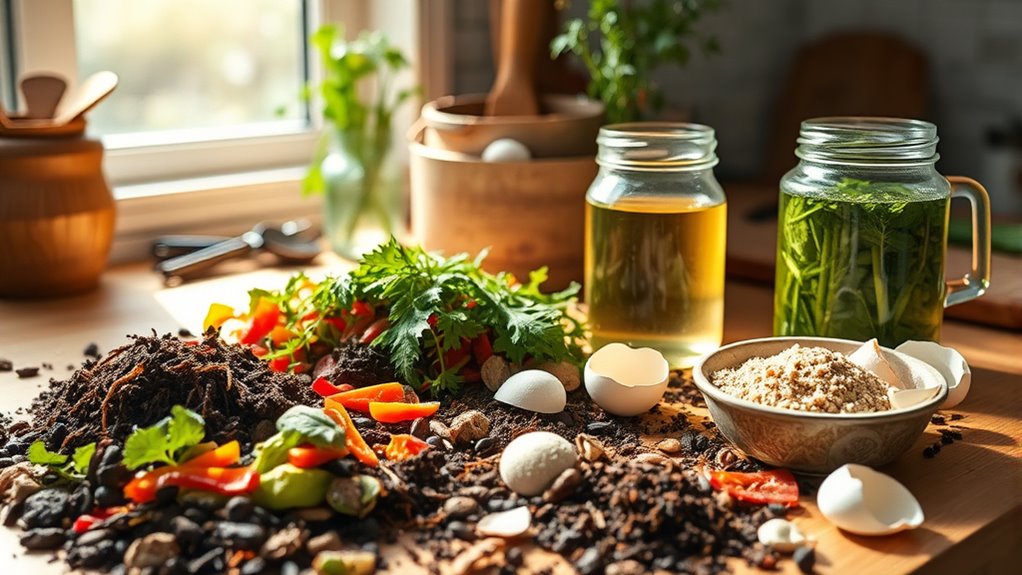
When it comes to homemade organic fertilizers, you've got plenty of options at your fingertips.
From kitchen scraps like coffee grounds and eggshells to nutrient-rich compost and fish waste, each type serves a unique purpose for your plants.
Let's explore how these different sources can boost your garden's health and growth.
Types of Homemade Fertilizers
Homemade fertilizers come in various forms, each offering unique benefits for your garden. You can use coffee grounds, packed with nitrogen, to boost soil fertility.
Banana peels are another excellent option; they're rich in potassium and can be dried and ground into a powder for easy application.
Don't forget about compost tea, a liquid fertilizer made by steeping compost in water, which provides a readily available nutrient solution for your plants.
Additionally, integrating fruit and vegetable scraps into your compost creates a nutrient-dense mixture that enhances soil health.
Finally, fresh grass clippings can also be tilled into the soil for added nitrogen and potassium, while helping retain moisture and suppress weeds. By regularly reflecting on self-care practices, you can improve your gardening experience by enhancing your overall well-being and focus.
Nutrient Sources for Plants
Understanding the nutrient sources available for your plants is crucial for promoting healthy growth and yields.
Organic fertilizers, such as coffee grounds, banana peels, and eggshells, provide key nutrients like nitrogen, potassium, and phosphorus.
Coffee grounds, rich in nitrogen (about 2.0-2.5% N), improve soil structure and attract beneficial earthworms.
Eggshells, primarily calcium carbonate, supply considerable calcium, essential for plant cell wall strength.
Banana peels offer an excellent source of potassium (around 0.6% K) and phosphorus (approximately 0.1% P), which boosts flowering and fruiting in plants.
Additionally, grass clippings, containing roughly 4% nitrogen, work as a natural fertilizer and mulch, helping retain moisture and suppress weeds.
Incorporating these sources into your gardening routine can enhance your plant health markedly. Furthermore, utilizing deter scratching methods can help protect your garden tools and furniture from any potential damage caused by pets.
Using Your Homemade Fertilizer
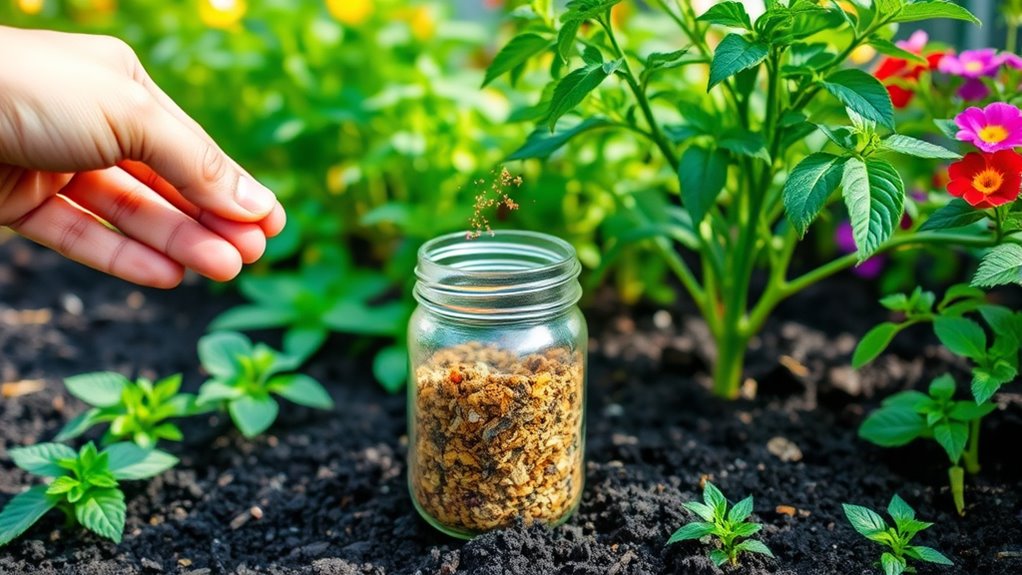
Utilizing your homemade fertilizer effectively can greatly enhance your plants' growth. To make an organic plant fertilizer, apply it every 2-4 weeks, ensuring a steady supply of nutrients, including potassium and calcium, without over-fertilizing.
Enhance your plants' growth by applying homemade organic fertilizer every 2-4 weeks for optimal nutrient supply.
If you're using liquid fertilizers made from food waste, dilute it properly—mix 1 part fertilizer with 8-15 parts water, depending on how long you soaked the scraps.
For solid fertilizers, like ground coffee, eggshells, or banana peels, sprinkle them lightly around your plants and mix them into the soil once every few weeks.
Always monitor the soil condition and your plants' response to adjust the frequency and quantity as needed.
Store any leftovers in airtight containers to maintain effectiveness for future use.
Tips for Sustainable Gardening Practices
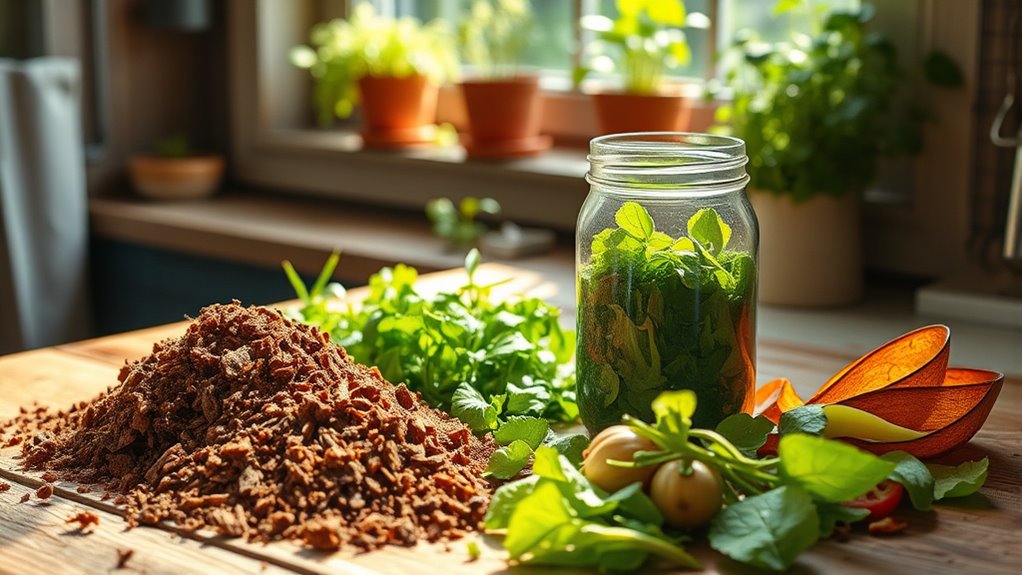
Sustainable gardening practices not only benefit your plants but also contribute to a healthier environment. You can start by utilizing kitchen scraps like coffee grounds, eggshells, and banana peels to create homemade fertilizers, reducing waste and reliance on synthetic options.
Build a compost pile with organic materials to enrich your soil, improving its structure and moisture retention over time. Consider crop rotation and companion planting to enhance soil health and naturally deter pests without chemicals.
Opt for native plants, as they require less water and maintenance while supporting local biodiversity. Finally, install rain barrels to collect rainwater for irrigation, conserving resources and cutting down on utility costs. Additionally, monitor for aggressive behaviors when planting diverse species together to ensure a harmonious garden.
Embracing these tips fosters sustainable gardening and a thriving garden.
Frequently Asked Questions
What Is the Best Homemade Fertilizer?
The best homemade fertilizer balances nitrogen, phosphorus, and potassium.
You'll find that coffee grounds, eggshells, and banana peels are excellent sources. Coffee grounds boost nitrogen levels, eggshells add calcium and phosphorus, while banana peels deliver potassium.
Combine these materials in equal parts, grind them into a powder, and apply every 2-4 weeks. This slow-release method nourishes your plants without the risk of over-fertilization, promoting healthy growth and recycling kitchen scraps in the process.
How Can We Make Fertilizer at Home?
To make fertilizer at home, start by collecting common kitchen scraps like coffee grounds, eggshells, and banana peels.
Dry them in sunlight for a few days to remove moisture. Once dried, grind them into a fine powder for better nutrient release.
Mix equal parts of the ground scraps to create a balanced fertilizer.
Finally, sprinkle it onto your soil every 2-4 weeks, ensuring you use it moderately to avoid over-fertilization.
What Are the Disadvantages of Banana Peels as Fertilizer?
When using banana peels as fertilizer, you might face several disadvantages.
They're low in nitrogen, which can lead to nutrient imbalances in your plants. If not dried properly, they can attract pests and promote fungal growth.
Their slow decomposition may not provide the quick nutrient boost fast-growing plants need. Additionally, over-applying banana peels can create excess potassium, potentially harming your plants and introducing pathogens that compromise soil health.
How Do You Make Basic Fertilizer?
To make basic fertilizer, you'll need dried and ground coffee grounds, crushed eggshells, and dried banana peels.
First, dry the coffee grounds in sunlight for about 1 to 1.5 days before grinding them. Rinse and dry the eggshells, then grind them into a fine powder.
Finally, dry the banana peels until brittle and grind them as well.
Mix these components and apply to your soil every 2-4 weeks for healthy plants.
Conclusion
By crafting your own fertilizer, you're not just nourishing your plants; you're nurturing the earth, much like a gardener in Eden. This simple act of recycling and repurposing can transform your garden into a haven of life. As you embrace these sustainable practices, remember that every little effort counts in the grand tapestry of nature. So, get your hands dirty and watch your garden flourish, proving that even small actions can lead to a bountiful harvest.



